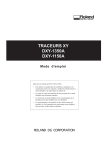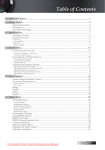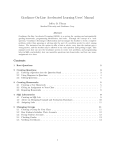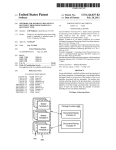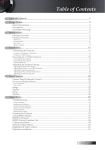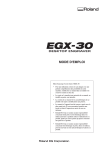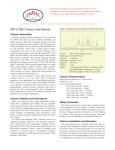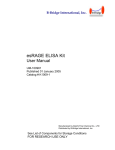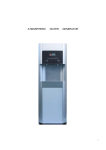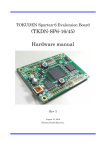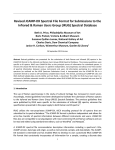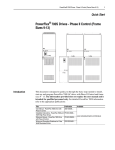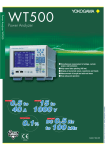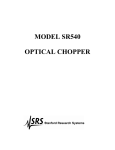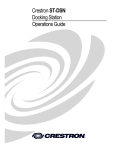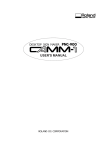Download XY PLOTTER DXY-1350A DXY-1150A
Transcript
XY PLOTTER
DXY-1350A
DXY-1150A
USER'S MANUAL
Thank you very much for purchasing the DXY-1350A/1150A.
•
To ensure correct and safe usage with a full understanding of
this product's performance, please be sure to read through this
manual completely and store it in a safe location.
•
Unauthorized copying or transferral, in whole or in part, of
this manual is prohibited.
•
The contents of this operation manual and the specifications of
this product are subject to change without notice.
•
The operation manual and the product have been prepared and
tested as much as possible. If you find any misprint or error,
please inform us.
For the USA
FEDERAL COMMUNICATIONS COMMISSION
RADIO FREQUENCY INTERFERENCE
STATEMENT
This equipment has been tested and found to comply with the
limits for a Class A digital device, pursuant to Part 15 of the
FCC Rules.
These limits are designed to provide reasonable protection
against harmful interference when the equipment is operated
in a commercial environment.
This equipment generates, uses, and can radiate radio
frequency energy and, if not installed and used in accordance
with the instruction manual, may cause harmful interference
to radio communications.
Operation of this equipment in a residential area is likely to
cause harmful interference in which case the user will be
required to correct the interference at his own expense.
For Canada
CLASS A
NOTICE
This Class A digital apparatus meets all requirements of the
Canadian Interference-Causing Equipment Regulations.
CLASSE A
AVIS
Cet appareil numérique de la classe A respecte toutes les
exigences du Règlement sur le matériel brouilleur du
Canada.
Unauthorized changes or modification to this system can void
the users authority to operate this equipment.
The I/O cables between this equipment and the computing
device must be shielded.
ROLAND DG CORPORATION
1-6-4 Shinmiyakoda, Hamamatsu-shi, Shizuoka-ken, JAPAN 431-2103
MODEL NAME
: See the MODEL given on the rating plate.
RELEVANT DIRECTIVE : EC MACHINERY DIRECTIVE (89/392/EEC)
EC LOW VOLTAGE DIRECTIVE (73/23/EEC)
EC ELECTROMAGNETIC COMPATIBILITY DIRECTIVE (89/336/EEC)
Table of Contents
To Ensure Safe Use .................................................................................... 2
About the Labels Affixed to the Unit .................................... 4
Checking Accessories ................................................................................................ 5
Part Names and Functions ........................................................................................ 6
Step-by-Step Plotting .................................................................................................. 8
Setting Up the Stands ................................................................................................. 9
Connection .................................................................................................................. 10
Loading the Pens ....................................................................................................... 10
Loading the Paper ...................................................................................................... 11
Self-testing ................................................................................................................... 13
Installing the DRIVER ................................................................................................ 13
Downloading Plot Data ............................................................................................. 14
After Plotting ............................................................................................................... 16
Care and Maintenance .............................................................................................. 16
Explanation of Functions and Operation ............................................................ 17
Pens ............................................................................................................................... 18
Paper ............................................................................................................................. 21
Plotting Area ................................................................................................................ 22
DIP Switches ............................................................................................................... 24
What to Do If... ............................................................................................................ 26
List of DXY-GL Related Instructions ..................................................................... 28
List of RD-GL I Related Instructions ..................................................................... 29
List of RD-GL II Related Instructions .................................................................... 31
The Specifications of the Interface ....................................................................... 35
List of Optional Cables ............................................................................................. 38
List of Character Sets ............................................................................................... 39
Specification of DXY-1350A/1150A ........................................................................ 42
Windows is a registered trademark or trademark of Microsoft Corporation in the United States and/or other
countries.
Copyright © 1997 ROLAND DG CORPORATION
1
To Ensure Safe Use
About
and
Notices
Used for instructions intended to alert the user to the risk of death
or severe injury should the unit be used improperly.
Used for instructions intended to alert the user to the risk of injury
or material damage should the unit be used improperly.
* Material damage refers to damage or other adverse effects
caused with respect to the home and all its furnishings, as well
to domestic animals or pets.
About the Symbols
The
symbol alerts the user to important instructions or warnings. The specific
meaning of the symbol is determined by the design contained within the triangle.
The symbol at left means "danger of electrocution."
The
symbol alerts the user to items that must never be carried out (are
forbidden). The specific thing that must not be done is indicated by the design
contained within the circle. The symbol at left means the unit must never be
disassembled.
The
symbol alerts the user to things that must be carried out. The specific
thing that must be done is indicated by the design contained within the circle. The
symbol at left means the power-cord plug must be unplugged from the outlet.
Do not disassemble, repair, or
modify.
Doing so may lead to fire or abnormal operation resulting in injury.
Do not use with any electrical
power supply that does not
meet the ratings displayed on
the AC Adapter.
Use with any other power supply
may lead to fire or electrocution.
2
Do not use with any power
supply other than the dedicated AC adapter.
Use with any other power supply
may lead to fire or electrocution.
Do not use with a damaged
power cord or a power outlet
that is loose when the AC
adapter is plugged in.
Use with any
other power
supply may
lead to fire or
electrocution.
When unplugging the electrical
power cord from the power
outlet, grasp the plug, not the
cord.
Unplugging by
pulling the
cord may
damage it,
leading to
fire or electrocution.
Install on a stable surface.
Failure to do
so may result
in falling of the
unit or AC
adapter,
leading to
injury.
Do not injure or modify the
electrical power cord, nor
subject it to excessive bends,
twists, pulls, binding, or pinching, nor place any object of
weight on it.
Doing so may damage the electrical
power cord,
leading to
electrocution or fire.
When not in use for prolonged
periods, unplug the power
cord from the electrical outlet.
Failure to do so may
result in danger of
shock, electrocution,
or fire due to deterioration of the electrical
insulation.
Do not damage the
electrostatic pad, or attempt to
use tacks or the like to secure
paper or other material to the
pad.
Doing so may
lead to
electrocution.
Do not allow liquids, metal
objects or flammables inside
the machine.
Fire may
result.
3
About the Labels Affixed to the Unit
These labels are affixed to the body of this product.
The following figure describes the location.
Model name
DXY-1350A
DXY-1150A
Rear
Affixed to the 230 V/240 V adapter
Rating label
Use a rated power supply.
In addition to the
are also used.
and
symbols, the symbols shown below
: Indicates information to prevent machine breakdown or malfunction and ensure
correct use.
: Indicates a handy tip or advice regarding use.
4
Checking
Accessories
The following accessories are packed together with the main unit. Before using, be sure to check to make sure that
all accessories have been included.
Stand x 2 ( L and R)
Exclusive AC adapter x 1
Metal strip (DXY-1150A only ) x 3
Paper clip (DXY-1150A only ) x 1
Rubber positioning sticker
x 1 set
Transparent positioning sticker
x 1 set
PLOTTER DRIVER for
Windows® 3.1 x 1
PLOTTER DRIVER for
Windows® 95 x 1
Paper ( for self-test ) x 2
Standard ceramic pen
( for self-test ) x 1 set
Dust cover x 1
User's manual x 1
5
Part Names and
Functions
Pen stand
Pens can be stored here.
Drawing board
Paper is mounted here. (The DXY-1350A use
electrostatic adsorption, and the DXY-1150A is
equipped with a metal plate.)
Pen stock
Pens are loaded here.
Control panel
Used to make various settings
and operate the DXY.
Arm
This part moves over
the drawing board.
Pen carriage
Holds the pen when plotting.
Front View
Power switch
Pen type switch
Switches according to the type of pen
in use. (See " Pens".)
Power connector
Connects to the AC adapter
included with the main unit.
Side View
DIP switches
Used to make various settings.
Serial connector (RS-232C)
Used for connection to the
computer with a serial cable.
6
Parallel connector (Centronics specifications)
Used for connection to the computer with
a parallel cable.
Rear View
Control Panel
REPLOT LED (DXY-1350A only)
Lights up when replotting is possible.
[REPLOT MODE] key (DXY-1350A only)
Switches to the Replot mode. (See "Explanation of
Functions and Operation".)
[REPLOT] key (DXY-1350A only)
Press this key while the REPLOT MODE LED is lit to
execute replotting.
[PAPER HOLD] key (DXY-1350A only)
Causes paper to stick to the drawing board.
PAPER HOLD LED (DXY-1350A only)
Lights up during paper hold.
[PEN UP/DOWN] key
Press this key to move the pen up or down.
[ENTER] key
Use this key in combination with other keys to operate
the DXY.
[P1] and [P2] scaling point keys
Pressing the [P1] or [P2] key moves the pen
carriage to the specified position. (See "Explanation of Functions and Operation".)
[VIEW] key
Moves the carriage to the upper right of the
drawing board and pauses operation. Pressing the
key a second time return the pen carriage to the
pen position it was at immediately before.
VIEW LED
Lights up during VIEW
FAST
[FAST] key
Pressing this key speeds up carriage movement.
On the DXY-1150A, only the pen
number is shown. The following
functions are available only on the
DXY-1350A.
PEN
SPEED
8
420mm/sec
7
220mm/sec
PEN
SPEED
[PEN SPEED] key
Pen speed can be set by pressing
this key and the
"Pens".)
1
30mm/sec
key. (See
6
160mm/sec
5
120mm/sec
,
,
and
position keys
Moves the pen carriage. Pressing two adjacent
position keys at the same moves the pen carriage
diagonally.
POWER
ERROR
POWER/ERROR LED
Lights up when the power is turned on. This LED
also blinks when an error has occurred.
4
90mm/sec
3
60mm/sec
2
40mm/sec
1
8
30mm/sec
420mm/sec
[PENSELECT] key
The pen to be used can be
selected while this key is held
down.
1
30mm/sec
PEN SELECT
7
Step-by-Step
Plotting
Operation Flow
When using the DXY, plotting is carried out using the sequence of steps described below. Refer to the pages
indicated for each step for an explanation of how the operation is performed.
8
1
Set up the plotter.
2
Connect the AC adapter.
3
Connect the plotter to the computer.
4
Select the instruction set.
5
Make other required settings.
6
Load the pens.
7
Turn on the power.
8
Load the paper.
9
Set pen speed.
10
Download plot data from the computer.
Åù
Perform self-testing.
Be sure to follow this procedure when using the DXY for
the first time. If necessary,
steps 4 and 5 should also be
carried out.
These steps are carried out
when the computer connection
or the paper size has been
changed. All of these settings
are made using the DIP
switches.
Unless the usage environment
has been changed, these steps
are all that needs to be done to
make a plot.
When using the DXY for the
first time, or to confirm
operation of the plotter, a selftest can be carried out to check
the main unit for problems.
Setting Up the
Stands
Never install this unit in any of the following situations, as it could result in damage:
• Do not install the unit on an unstable surface.
• Places with excessive electrical noise.
• Places with excessive humidity or dust.
• The unit and AC adapter become hot during use. Avoid installation in an are a with poor
heat-radiating characteristics (poor ventilation).
• Avoid subjecting the unit to severe vibration or shocks.
• Places exposed to strong illumination or direct sunlight.
To Use the DXY Upright
1
2
To prevent interference with the arm when it
moves, do not place any objects in the shaded
area shown below.
Install the left and right stands included with the
plotter.
100 mm (3-15/16")
To Use the DXY Horizontally
1
To prevent interference with the arm when it moves, do not place any objects in the shaded area
shown below.
30 mm (1-3/16")
9
Connection
Before connecting the cable, make sure the computer's power and the DXY's power switch are
switched off.
Securely connect the power cord, computer I/O cable and so on so that they will not be unplugged
and cause failure during operation.
The arm and pen carriage move when the unit is switched on and while performing plotting --keep
hands and objects away at these times.
The rail moves simultaneously when the power is switched on. Do not place anu object on the
drawing board.
First switch on the power to the computer, then turn on the DXY.
Power connector
Parallel connector
Host computer
AC Adapter
RS-232C
connector
Parallel
connector
Serial
connector
Parallel interface cable
Serial interface cable
Loading the Pens
MPP Ink Pen
32 Color Plotter Pens
Refillable Ink Pen
Water Based Fiber Tipped Pen
Thick Water Based Fiber Tipped Pen Standard Ceramic Pen
Front
Rear
About the Rubber Pen-cap Fitting
Before loading the pens make sure that the pen cap rubbers are set correctly (The pen cap rubber is mounted on
the pen stock when the plotter is packed ). The pen cap rubbers help prevent the pen tips from drying out, but they
will not perform optimally unless they are mounted correctly.
Pen cap rubbers have fronts and backs, and either may be used depending on the type of pen each protects.
Removal
10
Pull the pen cap rubber off.
They can be relatively easily
removed from mechanical
pencils and ballpoint pens.
Mounting
While pressing the pen cap
rubber on with your fingers,
snap it onto the holder. Incorrect mounting may result in
ink leakage and improper pen
exchange.
Loading the Pens
*For additional information on pen types (options), refer to "Pens".
Load the pens only in the pen stock. Attempting to mount a pen directly in the pen carriage may
cause faulty operation.
Use only proprietary pens made exclusively for use with the DXY. Failure to do so may result in
faulty operation because of differences in pen length.
The effectiveness of the pen cap covers is only temporary. At the end of the work day, be sure to
attach the special pen caps and store the pens.
Load the pens in the pen stock. The pen stock can hold eight
pens at a time. Remove the cap from the pen, then while
pressing down on the pen cap rubber with the tip of the pen as
shown in the figure, gently press the pen into place so that the
round ridge on the pen goes into the groove on the pen stock.
(2)
If the pen is not loaded correctly it will cause
pen exchange errors. Be sure to load the pen
correctly as shown below.
* When using ink pen
Before loading into the
pen stock, write lightly on
a scrap of paper and
check ink flow.
(1)
Loading the Paper
After use, remove the pens from the pen stock,
cap securely, and store. Ink pen dry out
especially rapidly, which can cause the ink at
the tip to harden and interfere with normal use
later.
* When using the plotter for the first time, be sure to peel the
protective sheet (a sheet of thin, semitransparent vinyl) off the
drawing board.
Touching the surface of the paper with the hands may reduce plot quality because of the
adsorption of skin oils.
Adsorptive force may vary according to the type of paper. Adsorption of two or more sheets of
paper is not possible.
Adsorptive force is reduced in areas where temperature is extremely low. At such times, the
paper will adsorb is allowed to stand for a short while (10 seconds) after placement on the
drawing board. ( DXY-1350A only )
When opening a new package of paper, allow the paper to air for 30 minutes to an hour.
This airing helps prevent contraction or expansion of the paper due to humidity or temperature.
How to Load Paper on the DXY-1350A
1
Make sure the PAPER HOLD LED is not lit.
Place the paper according to its size as shown in the figure. (See a description of the plotting area.)
ISO A3
ISO A4
ANSI B
ANSI A
Approx. 10 mm
(3/8")
Approx.15 mm
(9/16")
11
2
After positioning, turn on the [PAPER HOLD]
key to secure the paper to the drawing board.
3
Remove bubbles and wrinkles from the paper by
wiping with a dry cloth.
PAPER
HOLD
How to Load Paper on the DXY-1150A
1
As shown in the figure, use the paper clip on the
left side of the unit to align the sheet of paper
evenly with the drawing board.
2
Remove bubbles and wrinkles from the paper, and
install the metal plate on the left side of the sheet.
Metal Strip
Paper clip
3
Install the metal plates at the top and bottom in the same way.
Rubber Positioning Stickers and Transparent Positioning Sticker
After plotting has been carried out a few times and the position of the paper becomes apparent, affix the
transparent and rubber positioning stickers included with the plotter to the drawing board. This enables
paper to loaded at the same place every time.
Transparent positioning sticker
位置決めラバーシール
Rubber
positioning sticker
12
Self-testing
The arm and pen carriage move when the unit is switched on and while performing plotting --keep
hands and objects away at these times.
Self-test Mode
A self-test can be carried out to check whether the DXY is functioning correctly. When doing this, the plotter does
not have to be connected to the computer.
This is actually the bottom of the page.
1. Load the pens included with the plotter in pen stocks 1
through 3. (See "Loading Pens.")
2. Turn on the power switch while holding down the
[ENTER] key.
3. The pen carriage moves to the upper right of the main
unit, and VIEW is enable (the VIEW LED lights up.)
4. Load an A3-size sheet of paper. (For instructions on
loading paper, see "Loading the Paper" on pages 8 and 9
for the DXY-1350A or on page 9 for the DXY-1150A.)
5. Press the [VIEW] key to disable VIEW.
6. The DXY then plots the self-test pattern.
When the pen is returned to the pen stock and the
carriage moves to the upper right of the main unit, the
self-test is finished.
The self-test plot is slightly larger than A4 size, so be
sure to use A3-size paper.
Installing the
DRIVER
The DXY-1350A/1150A comes with drivers for Windows 3.1 and Windows 95. Be sure to install the correct driver
for your operating system.
About Installation
Be sure to read the notes on how to install the driver in the file Readme.doc on the Setup disk. In addition to an
explanation of installation and setup methods, this file contains the latest information about the driver, the operating
environment, and other important matters. You can view this file with a text editor such as Notepad.
13
Downloading
Plot Data
Plot data is sent from the host computer (the program) to the DXY and plotted out.
Make the settings described below to match the program that you're using.
This example describes the general values for output (plotting). If you need detailed information about output
methods, please see the documentation for the software you're using.
Outputting Data from a Windows-based Program
When you are asked to select a printer, choose the DXY-1350A or DXY-1150A driver. At the driver setup screen,
make the setting for paper size, pen type, and so on.
Connecting with a Serial Cable
For the driver's port setting, set Flow control to [Hardware.]
For more information about other communication parameters, see "About the Settings for
Communication Parameters."
Setup Screen for Windows 3.1
Setup Screen for Windows 95
Selecting the Instruction Set
If you're using the driver for the DXY-1350A/1150A, select RD-GL I as the instruction set. See
"DIP Switches" for information on how to make this setting.
Outputting Data from an MS-DOS-based Program
When outputting data from a program, make the settings for the values described below.
Sample Application Software Output Device Selection Screen
Select DXY-1350A, or DXY1150A. If these selections are
not available, choose any
model in the DXY series. Also,
if RD-GL II has been selected
as the instruction set, choose
either the DPX series, GRX
series, or GSX series.
Select either the parallel
(Centronics) or the serial (RS232C) interface. Choose the one
that the host computer and the
DXY are connected by.
14
Output device selection
Device name
DXY-1350A DXY-1350A
DXY-1150A
DXY-1350
DXY-1250
Interface
RS-232C
Centronics
RS-232C
Paper size
A3
A3
A4
RD-GL I
DXY-GL
RD-GL II
OK
Select the paper
size you will use.
Select the
instruction set to
be used.
Settings for Communication Parameters
Using a serial (RS-232C) cable to connect the DXY with the computer enables the Auto-Protocol function,
which makes it unnecessary to set communication parameters on the DXY.
About Auto Protocol
Because the DXY can automatically determine communication parameters, plotting can be carried
out simply by downloading the plot data from the computer.
In order for the parameter settings to be made automatically, make sure that DIP switch [SW2-8]
on the back of the machine is set to [AUTO.]
Also, if the software is changed while in use, turn the power to the DXY off and then on again to
enable the Auto Protocol function to make the automatic determination of the communication
parameters.
Communication parameters can also be set without using Auto-Protocol, by follow the method described
below.
• Setting DIP switch [SW2-8] to "FIX" disables the Auto-Protocol function. The parameters in effect
when this is done are a baud rate (serial transmission rate) of 9600, using and 7-bit data
length with EVEN parity checking and one stop bit.
• Auto-Protocol can also be disabled by switching on the power while holding down a position key
and the [ENTER] key. The transmission rate is determined by which position key is held down.
Communication parameters other than transmission rate are determined by the setting for DIP
switch SW 2-8.
* These settings are lost when the power is switched off, and must be made again after
powerup.
Setting the baud rate
1200
Turn on the power while holding down the
and
keys.
2400
Turn on the power while holding down the
and
keys.
4800
Turn on the power while holding down the
and
keys.
9600
Turn on the power while holding down the
and
keys.
Setting communication parameters other than baud rate
DIP switch [SW 2-8] set to "AUTO":
8-bit data length, no parity, 1 stop bit
DIP switch [SW 2-8] set to "FIX":
7-bit data length, EVEN parity, 1 stop bit
15
After Plotting
1. Remove the paper.
DXY-1350A: Press the [PAPER HOLD] key to release the electrostatic adsorption and remove the
paper.
DXY-1150A: Remove the paper clip, release the metal strips, and remove the paper.
2. Turn off the DXY.
Switch off the power to the DXY. If the plotter will not be used for a long time, the electrical
cord should also be unplugged.
3. Remove the pens.
Remove all pens from the pen stock. Cap and store the pens after use.
Care and
Maintenance
Be sure to turn off the power to the DXY before cleaning.
Never attempt to oil or lubricate the mechanism.
The drawing board for the DXY-1350A is an electrostatic pad. When cleaning the drawing board,
never use water, silicone cloth, neutral detergent, solvent, or chemically-treated cloth. Such materials
can permanently degrade the board's electrostatic adhesive force.
Cleaning the Main Unit
If the unit becomes dirty, wipe gently using a cloth moistened with water or anhydrous alcohol.
Cleaning the Drawing Board
Gently wipe with a soft cloth. If soiling is severe or the adsorptive force of the drawing board is weak
(DXY-1350A only), wipe gently using a cloth moistened with ethyl alcohol. The DXY-1350A use an
electrostatic adsorption drawing board, which must never come in contact with water, neutral detergents,
solvents, silicone cloth, or any other type of chemically treated wiper cloths, as these will irrevocably
diminish the electrostatic adsorptive force.
Cleaning the Pen Cap Rubbers
Ink buildup on the pen cap rubbers may soil plots. Remove the pen cap rubbers and wash with water.
Replace them on the pen stock after allowing to dry completely (out of direct sunlight).
16
Explanation of
Functions and
Operation
The DXY has a range of functions that can be performed using
the keys on the control panel. This section describes how to
use these functions.
< Replotting (DXY-1350A Only) >
1. Before downloading the plot data, press the [ REPLOT MODE ] key.
The REPLOT MODE LED lights up.
2. Use the computer software to download the plot data.
3. Load a sheet of paper and press the [ REPLOT ] key.
< Erasing Data in the Plotter >
1. Press the [ VIEW ] key.
The pen carriage moves to the upper right of the main unit and stops.
2. While holding down the [ ENTER ] key, press the
key.
Hold down
< Stopping a Plot >
1. Press the [ VIEW ] key.
The pen carriage moves to the upper right of the main unit and stops.
2. Use the computer software to stop sending plot data to the DXY.
3. While holding down the [ ENTER ] key, press the
key.
Plot data remaining in the plotter is deleted.
Hold down
< Setting Scaling Points ( P1 and P2 ) >
1. Use the
,
,
,
and [ FAST ] keys to move the pen carriage
to the position for setting P1 or P2.
2. While holding down the [ ENTER ] key, press the [ P1 ] or the [ P2 ]
key.
or
Hold down
< Enabling the Non-buffer Mode >
In the Non-buffer mode, data downloaded from the computer is plotted
simultaneously, with no data stored in the buffer within the DXY. This can
be handy when debugging a program or testing connections.
1. Turn on the power while holding down the
key.
POWER
ON
Hold down
< Enabling the List Mode >
In the List mode, data downloaded from the computer is printed as-is,
without processing. This is handy for confirming program content.
1. Load paper and a pen (pen No. 1).
2. Turn on the power while holding down the [ VIEW ] key. The pen
carriage grasps the pen, moves to the upper left, and awaits data from the
computer.
POWER
ON
Hold down
17
This section describes the pens optionally available for use with
the DXY, as well as the DXY's pen-related functions. Compatibility exists for pens and paper. Please refer to the information
contained here to select combinations with good compatibility.
Pens
By selecting optimum conditions for the pen and paper that are used, the DXY can achieve more accurate plots.
OHP Mode ( Pen speed is controlled at 100 mm (13-15/16")/sec. )
Select this mode when using standard ceramic pens to make plots on OHP transparency sheets.
Turn on the power while holding down the [ FAST ] key.
Ink Pen Mode ( Pen speed is controlled at 100 mm (13-15/16")/sec.)
Use this mode when plotting with MPP pens or refillable ink pens.
Turn on the power while holding down the
key on the control panel.
Cutting Mode (Cutting Speed Controlled at 10 mm (3/8")/sec)
This mode is selected when using the DXY to carry out cutting. Use the DIP switches on the back of the
machine to set the cutting offset, then turn on the power to the unit. (See "DIP Switches" for details on the
cutting function.)
Setting Pen Speed (DXY-1350A Only)
While holding down the [ PEN SPEED ] key, press any one of the [ PEN SELECT ] keys from 1 to 8. The
chart below shows the pen speeds that can be set with these keys. This function is handy when the optimum speed
for the pens being used is known. Pen speed is set to the same value for all pens.
Pen No
1
2
3
4
5
6
7
8
Pen Speed
30 mm/sec 40 mm/sec 60 mm/sec 90 mm/sec 120 mm/sec 160 mm/sec 220 mm/sec 420 mm/sec
3/16"
9/16"
2-3/8"
3-9/16"
4-3/4"
6-5/16"
8-11/16"
16-9/16"
OHP Mode
30 mm/sec 40 mm/sec 60 mm/sec 90 mm/sec 100 mm/sec 100 mm/sec 100 mm/sec 100 mm/sec
3/16"
9/16"
2-3/8"
3-9/16"
3-15/16"
3-15/16"
3-15/16"
3-15/16"
Ink Pen Mode
30 mm/sec 40 mm/sec 60 mm/sec 90 mm/sec 120 mm/sec 160 mm/sec 200 mm/sec 200 mm/sec
3/16"
9/16"
2-3/8"
3-9/16"
4-3/4"
6-5/16"
7-7/8"
7-7/8"
Changing Maximum Plotting Speed
The DIP switches on the back of the DXY can be used to change the maximum plotting speed. When shipped from
the factory, maximum plotting speed is set at 420 mm (16-9/16")/sec (all directions), but when set to [FAST] ,
maximum plotting speed is 600 mm (23-5/8")/sec (45° orientation).
Pen Type Switch
The pen type switch on the side of the main unit can be used to select [Long] or [Short] to match the pen holder in
use. The descriptions of the different pens that are available also list the type to be set, so be sure to select the
appropriate pen type.
Auto Pen-up and Auto Pen-return Functions
To prevent ink from running or blotting the paper, the DXY features an Auto Pen-up function, which automatically
lifts the pen during plotting when approximately three seconds elapse with no data received from the computer.
Moreover, is approximately 50 seconds pass with no plot data received, the Auto Return function automatically
returns the pen from the carriage to the pen stock. Because there is a pen cap rubber fitted into the pen stock, this
can prevent the pen tip from drying out.
18
Standard Ceramic Pen
Plotting distance
(with our standard paper)
Pen cap rubber
orientation
0.25 mm : 2000 m
(0.00984":78740")
0.35 mm : 1300 m
(0.0138" :51181")
0.50 mm : 700 m
(0.0197" :27559")
0.70 mm : 400m
(0.0276" :15748")
Features
The pen tip is a ceramic tube, with ink flowing through it to
form the line
Because pen tip diameter is uniform, line thickness is uniform
from start until the ink runs out
Pen widths of 0.25 mm (0.00984"), 0.35 mm (0.0138"), 0.50
mm (0.50 mm), and 0.70 mm (0.0276") are available, allowing
use for plots or business graphics.
Water-soluble ink available in eight colors (black, red, blue,
green, orange, pink, brown and purple)
Applicable paper
High-quality paper, tracing paper
Pen type
Short
NOTE
Because these are dye-based inks, plots made with these pens
will fade if left exposed to sunlight for long periods. Store
plots made using these pens out of direct sunlight.
Water Based Fiber Tipped Pen
Water Based Fiber Tipped
Features
Plotting distance
(with our standard paper)
Pen cap rubber
orientation
Excellent coloration for colorful illustrations
Comes in eight colors (black, red, blue, green, brown, purple,
pink, orange), and two pen tip thicknesses (0.3 mm (0.0118") and
0.6 mm (0.0236"))
NOTE
Long-term use will cause the pen tip to wear, causing a gradual
increase in line width.
Because these are dye-based inks, plots made with these pens will
fade if left exposed to sunlight for long periods. Store plots made
using these pens out of direct sunlight.
32 Color Plotter Pens
0.3 mm : 400 m
(0.0118":15748")
0.6 mm : 300 m
(0.0236" :11811")
Applicable paper
High-quality paper, coated paper, tracing paper
water based OHP film
Pen type
Short
Plotting distance
(with our standard paper)
Pen cap rubber
orientation
0.3 mm : 400 m
(0.0118":15748")
0.6 mm : 300 m
(0.0236 :11811")
Features
Variety of colors and shades for colorful expression
Optimum for illustrations, graphs and graphics
Fiber pen tip for simple use
Two pen tip thicknesses - 0.3 mm (0.0118") and 0.6 mm
(0.0236")
Following pen colors available:
Applicable paper
High-quality paper, coated paper, tracing paper
water based OHP film
Pen type
Short
Black
Brown
Red
Yellow
Green
Blue
Violet
Magenta
Dark Brown
Mahogany
Poppy Red
Golden Yellow
Forest Green
Cobalt Blue
Dark Purple
Purple
Grey
Pine
Orange
Lime Green
Kelly Green
Sky Blue
Mauve
Rose Pink
Warm Grey
Beige
Peach
Lemmon Lime
Olive Green
Ice Blue
Turquoise
Pale Pink
NOTE
Long-term use will cause the pen tip to wear, causing a
gradual increase in line width.
Because these are dye-based inks, plots made with these pens
will fade if left exposed to sunlight for long periods. Store
plots made using these pens out of direct sunlight.
19
Thick Water Based Fiber Tipped Pen
Pen cap rubber
orientation
Features
Thick water-based fiber tipped pen draws a 2 mm thick line
Comes in eight colors (black, red, blue, green, orange, pink,
brown, purple)
Optimum for advertising and illustration, because large areas
can be colored quickly
Plotting distance
(with our standard paper)
2 mm : 100 m
(1/16":3937")
Applicable paper
High-quality paper, coated paper, tracing paper
Water based OHP film
Pen type
Short
NOTE
Plots made with these pens will fade if left exposed to sunlight
for long periods. Store plots made using these pens out of direct
sunlight.
Standard Ceramic Pen
MPP Pen
Pen cap rubber
orientation
Features
No need to refill ink, and maintenance much simpler than
refillable ink pens.
Plots sharp, attractive lines, with no change in line thickness
or ink flow even over long periods of time.
Non-refillable ink pens come in paper and film types. Select
the ink pen appropriate for the media you will be using.
When the film ink pen is used on film, the output can be
erased with a commercially-available drafting ink eraser.
When the paper ink pen is used on tracing paper, the output
can be erased with a commercially available ink eraser
(unless paper moisture absorption is high).
Refillable Ink Pen
0.25 mm : 2500 m
(0.00984":98425")
0.35 mm : 1800 m
(0.0138" :70866") (for paper)
0.50 mm : 1400 m
(0.0197" :55118")
0.70 mm : 800 m
(0.0276" :31496")
Applicable paper
For paper: High-quality paper, tracing paper
For film: Drafting film
Pen type
Pen cap rubber
orientation
20
Long
Plotting distance
(with our standard paper)
0.35 mm: 300 m
(0.0138":11811")
Pen tip will wear out in 6000 m
(236220") to 10000 m (393700")
of travel
Features
The same pen can be refilled and used any number of times.
Plots sharp, attractive lines, with no change in line thickness or
ink flow even over long periods of time.
Refillable ink pens come in paper and film types. Select the ink
pen appropriate for the media you will be using.
When the film ink pen is used on film, the output can be erased
with a commercially-available drafting ink eraser.
When the paper ink pen is used on tracing paper, the output can
be erased with a commercially available ink eraser (unless
paper moisture absorption is high).
Plotting distance
(with our standard paper)
Applicable paper
For paper: High-quality paper, tracing paper
For film: Drafting film
Pen type
Long
This chapter describes the optional paper that can be used with
the DXY. Refer to the table below in paper selection.
Paper
Paper type
Hi gh-qual i ty paper
Coated paper
Dimensional
stability
Characteristics
Compatible pens
Thi s i s the most economi cal whi te paper. I t
tends to contract and expand f ai rl y easi l y, and
i nk wi l l spread sl i ghtl y, maki ng i t i nappropri ate
f or appl i cati ons requi ri ng hi gh preci si on.
Ref i l l abl e i nk pen f or paper
M PP pen f or paper
32 col or pl otter pens
Water based f i ber ti pped pen
Thi ck water based f i ber ti pped pen
Standard Cerami c pen
Water based f i ber ti pped pen
Thi ck water based f i ber ti pped pen
32 col or pl otter pens
Whi teness i s hi gher than hi gh-qual i ty paper.
Thi s paper shows mi ni mal contracti on or
expansi on due to changes i n envi ronmental
f actors such as humi di ty.
Common natural type traci ng paper.
Sui ted to bl uepri nts. I nk pen i s the best pen
type.
Traci ng paper
Ref i l l abl e i nk pen f or paper
M PP pen f or paper
32 col or pl otter pens
Water based f i ber ti pped pen
Thi ck water based f i ber ti pped pen
Standard Cerami c pen
Draf ti ng f i l m
Pol yester f i l m, wi th a matte f i ni sh on both
Ref i l l abl e i nk pen f or f i l m
si des. Has l ow expansi on and contracti on, and
M PP pen f or f i l m
shows smal l change over ti me, maki ng i t
opti mum f or j obs where preci si on i s essenti al .
Use opti onal i nk pens f or f i l m.
Water bas dOHP f i l m
Oi l basedOHP f i l m
Thi s i s transparent f i l m f or use wi th overhead
32 col or pl otter pens
proj ector (OHP) devi ces.
Oi l based f i ber ti pped pen
Optimum
Good
Paper expands and contracts by absorbing the moisture in the air.
Always plot after getting the paper accustomed to the ambient temperature and humidity. This optimum time will vary with
the specific paper type, but generally 30 to 60 minutes after removal from the paper bag is appropriate.
Oil on the paper surface may cause poor performance
Take care when loading the paper to prevent transfer of oils or dirt from your hand to the paper surface.
When using paper not supplied by Roland
DG Corp., observe the following points in
Plot quality and paper
making your selection:
Plot quality changes with the following conditions:
Does the ink work well with the paper?
(moisture absorption characteristics,
Condition
Effect
coloration)
Is the ink faint? (at the rated pen speed)
Ambient temperature Paper expansion and contraction causes offset and
Does the ink spread? (line thickness should
and humidity
ink blotting
not change with time)
Pen speed
The line will be faint if the pen speed is too high
Speed of drying (If one line crosses another,
Pen force
Pen and paper will be damaged if set too high,
ink should not mix)
and line will be faint is set too low
Does pen clog?
Paper type
Moisture absorption characteristics and surface
Other factors such as paper strength, etc.
roughness will affect line darkness, coloration
and pen clogging.
21
Plotting Area
The maximum size of the plotting area varies according to the selected instruction set and operation steps, even when
using the same size of paper. For an explanation of how to load and position paper, see "Loading the Paper" on
pages 8 and 9.
Size-reduced Plotting
The settings of the DIP switches on the back of the main unit of the DXY can be changed to reduce plot size and
make ISO A0, A1, and A2-size plots on A3-size paper (or ANSI E, D, and C-size plots on ANSI B-size paper).
This function is only effective when RD-GL II is selected as the instruction set and paper size is set at ISO A3
(or ANSI B) using the DIP switches. For details, see the plotting areas for size-reduced plotting that are given on
the following page.
Expand Mode
The DIP switch settings of the DXY can be used to set the plotting area. When DXY-GL or RD-GL I has been
selected for the instruction set and the Expand mode is turned on, the size of the expanded plotting area matches
ANSI B and ISO A3. When RD-GL II is chosen, the size of the plotting area when expanded varies according to
paper size. The table below shows the size of the plotting area when the Expand mode is enabled.
ANSI B
ISO A3
EXPAND ON
RD-GL I, DXY-GL ( 1 step/0.025 mm )
Paper size
ISO A3
ISO A4
ANSI B
ANSI A
EXPAND
Maximum plotting
area (mm) / (inch)
403.95
15-7/8"
276
10-13/16"
276
193.025
10-13/16"
7-9/16"
416
259.125
16-3/8"
10-3/16"
259.125
10-3/16"
431.8
17"
199.05
7-13/16"
297
11-11/16"
Maximum plotting area
(coordinates)
SW1-1
DIP switch settings
SW1-2
SW1-5
16158 , 11040
OFF
OFF
OFF
11040 , 7721
OFF
ON
OFF
16640 , 10365
ON
OFF
OFF
10365 , 7962
ON
ON
OFF
17272 , 11880
Varies according to paper size
ON
DXY-GL ( 1 step/0.1 mm )
Paper size
ISO A3
ISO A4
ANSI B
ANSI A
EXPAND
22
Maximum plotting
area (mm) / (inch)
403.9
15-7/8"
10-13/16"
276
193.0
10-13/16"
7-9/16"
416
16-3/8"
259.1
10-3/16"
259.1
10-3/16"
431.8
17"
276
199.0
7-13/16"
297
11-11/16"
DIP switch settings
Maximum plotting area
(coordinates)
SW1-1
SW1-2
SW1-5
4039 , 2760
OFF
OFF
OFF
2760 , 1930
OFF
ON
OFF
4160 , 2591
ON
OFF
OFF
2591 , 1990
ON
ON
OFF
4318 , 2970
Varies according to paper size
ON
RD-GL II
Paper size
ISO A3
EXPAND
ISO A4
EXPAND
ANSI B
EXPAND
ANSI A
EXPAND
Maximum plotting
area (mm) / (inch)
390
267
(15-5/16"
420
297
267
180
297
401.8
249.4
11")
249.4
185.9
(9-13/16"
279.4
(11"
ON
OFF
ON
ON
± 8036, ± 4988
9-13/16")
(17"
OFF
± 5940, ± 4200
8-1/4")
279.4
OFF
OFF
210
431.8
OFF
SW1-5
± 5340, ± 3600
7-1/16")
(11-11/16"
SW1-2
± 8400, ± 5940
11-11/16")
(10-1/2"
DIP switch settings
SW1-1
± 7800, ± 5340
10-1/2")
(16-1/2"
(15-13/16"
Maximum plotting area
(coordinates)
OFF
ON
OFF
± 8636, ± 5588
ON
± 4988, ± 3718
7-5/16")
OFF
ON
215.9
ON
± 5588, ± 4318
8-1/2")
ON
Plotting areas for size-reduced plotting
Normal Mode
Paper
Paper size
1159 mm
ISO A0
(45-5/8"
(-23180, -16220)
811 mm
ISO A1
(31-7/8"
(-16220, -11280)
564 mm
ISO A2
(22-3/16"
(-11280, -7800)
ANSI E
1189 mm
31-7/8")
(46-3/4"
(23180, 16220)
(-23780, -16820)
841 mm
594 mm
22-3/16")
(15-5/16"
10-1/2")
( 33-1/16"
23-3/8")
390 mm
(When reduced to ISO A3
size)
(-16820-, 11880)
594 mm
15-5/16")
(23-3/8"
(11280, 7800)
(-11880, -8400)
(42-13/16"
32-13/16")
(44"
(21752, 16672)
(-22352, -17272)
528.8 mm
401.8 mm
249.4 mm
( 32-13/16" 20-13/16")
(15-13/16"
9-13/16")
(34"
(16672, 10576)
(When reduced to ANSI B
(-17272, -11176)
401.8 mm
size)
528.8 mm
(20-13/16"
(-10576, -8036)
(23780, 16820)
267 mm
1117.6 mm
(-16672, -10576)
33-1/16")
390 mm
(16220, 11280)
15-13/16")
(10576, 8036)
863.6 mm
558.8 mm
(22"
(-11176, -8636)
Size-reduced plotting area
841 mm
564 mm
833.6 mm
833.6 mm
ANSI C
811 mm
Paper SIze
1087.6 mm
(-21752, -16672)
ANSI D
Expand ON
Size-reduced plotting area
(16820, 11880)
420 mm
420 mm
(16-1/2"
297 mm
11-11/16")
(When reduced to ISO A3
size)
16-1/2")
(11880, 8400)
863.6 mm
34")
(22352, 17272)
558.8 mm
431.8 mm
22")
(17"
279.4 mm
11")
(17272, 11176)
(When reduced to ANSI B
431.8 mm
size)
17")
(11176, 8636)
• Refer to the above chart when performing size-reduced plotting. Coordinate values are given beneath the
indications in millimeters.
• When any member of the DPX Series has been selected as the output device for the computer, the position of the
origin point differs from the DXY. For this reason, data outside the coordinates is not plotted when size-reduced
plotting is carried out.
23
DIP Switches
* DIP switches settings must be made only when the
power is turned off.
The DIP switches on the back of the main unit can be used in various combinations to enable a variety of plotting
conditions. Please change these settings to match your needs. These are all set to OFF when the DXY-1350A/
1150A is shipped from the factory.
SW 1-1
SW 1-2
ISO or ANSI
Paper size
SW 1-1 selects either ANSI or ISO size. SW 1-2 selects ISO A3 or A4 (ANSI B or A) size paper.
SW 1-3 and -4 Size-reduced plotting
Enables plots for ISO A0, A1, or A2 paper size to be reduced in size for plotting on ISO A3-size paper. Change the
switch settings to match the original size. Size-reduced plotting is enabled only when [ A3 B ] is selected with
SW 1-2 and [ RD-GL II ] is chosen using SW 2-9 and -10.
SW 1-5
Expanded plotting area
Set this switch to ON when an expanded plotting area is desired. For details, see " Plotting Area" .
24
SW 1-6
Plot rotation
When this switch is set to ON, the normal plot orientation is rotated 90°.
When OFF
SW 1-7
When ON
Plotting speed
This selects plotting speed. When shipped from the factory, this is set to [ NORMAL ], for a maximum plotting
speed of 420 mm/sec in all directions. When [ FAST ] is selected, maximum plotting speed is set at 600 mm/sec
(45° orientation).
SW1-9, -10 Performing Cutting
With the purchase of the optional Blade Holder Set (DXY-BHS), the DXY can be used to cut special sheets. In
order to for corners to be cut accurately, the tip of the blade requires an offset. This switch is used to set the
appropriate offset value for the blade. When using the blades included in the Blade Holder Set, this should be set
to 0.25 mm.
Cautions When Performing Cutting
• Make sure that the installation of the DXY is flat and level.
• The DXY cannot be used to cut fluorescent or thick sheets.
• Pen changing is not performed when in the cutting mode. Be sure that the blade holder is installed in the pen
carriage.
• When carrying out cutting, be sure to spread out a cutting-use protective pad to prevent damage to the drawing
board.
• When cutting, use cellophane tape to secure the sheet and cutting-use protective pad in place. Because the metal
plates and paper clips for the DXY-1150A make strike and damage the blade during cutting, use of these should
be avoided.
SW 2-1 to -4
Character set selection
The DXY has 19 character sets, and this selects the one enabled when power is turned on. See "Character Sets" for
a list of available character sets.
SW 2-8
Auto Protocol function
Set this to [ AUTO ] for automatic determination of communication parameters. When set to [ FIX ], communication parameters are a bit rate of 9,600 baud, even parity, data length of 7 bits, and one stop bit.
SW 2-9 and -10
Instruction set selection
Make this setting to correspond to the instruction set in use. When using DXY-GL, set the operation step at 1 step/
0.1 mm (0.00394") or 1 step/0.025 mm (0.000984").
When performing output with the driver included with the DXY-1350A/1150A, select RD-GL I.
25
What to Do If...
If the DXY Doesn't Run...
Is the DXY power on?
Turn on the power.
Is the DXY operating incorrectly
Follow the procedure described under " Self-testing " to execute a self-test. If the self-test finds a problem,
check to make sure that the problem is not due to the computer or the software.
Computer
Is the computer set up correctly?
Check the following items:
• DIP switches
• Memory switches
• Interface board
Read the computer user’s manual and set it up correctly.
• Other
Connection cable
Are the computer and the plotter linked with the right cable?
The type of cable you need is determined by your computer and the software you are using. Even if the
computer is the same, running different software may require a different cable. Use the cable specified in your
software.
Is the cable making a secure connection?
Connect securely.
Software
Is the OS set up correctly?
Check the following items:
• Output port selection
• Output device selection
Check the OS user’s manual and set it up correctly.
• Output port open
• Other
Are the application software settings correct?
Check the following items:
• Output device specification (select a plotter name that matches the instruction system. If the wrong
plotter is selected an incorrect instruction may be output, resulting in an error).
• Communication parameters
• Other
Check the software user's manual and set it up correctly.
Pen is not grasped or returned normally
Is the pen loaded correctly?
Please refer to "Loading the Pens" to install the pens correctly.
Is the pen cap rubber installed so that it is oriented correctly?
Install the pen cap rubber correctly as described.
26
Plot quality is poor
Is the paper of the recommended type?
Refer to the chart shown in " Paper " and load a paper type that is suitable for the DXY.
Is the paper loaded correctly?
Read “ Loading the paper ”, and load the paper correctly.
Do the pens match the paper type?
Read “ Pens ” and “Paper ”, and use an appropriate type of pen.
Are the DIP switches set for the Cutting Mode?
When plotting with a pen, be sure to set DIP switches SW1-9 and SW1-10 to OFF.
If DIP switches SW-1-9 and SW-1-10 are not both set to OFF, the DXY remains in the Cutting Mode. Attempting pen plotting while the Cutting Mode is enabled will result in poor output quality for text, circles, and other
short lines. This is because the DXY is performing processing that enables a blade to cut the cutting sheet
smoothly.
Plot size is wrong
If application software is being used, is the setting for the output size correct?
Read the operation manual for the software you are using, and make the correct settings for the plot size.
Are the DIP switch settings correct?
The DXY can reduce plot size to print ISO A0, A1, or A2-size plot data on A3-size paper (or ANSI E, D, or Csize data on B-size paper). Size-reduced plotting cannot be performed on A4-size paper (or ANSI A-size
paper). To make size - reduced plot, see " Plotting Area " and "DIP Switches ".
Plotting position and range are different
If application software is being used, is the setting for the output position and range correct?
Read the operation manual for the software you are using, and make the correct settings for the output position
and range.
Is the same instruction set selected for the computer and the DXY?
The settings for the computer and the DXY do not match. If you have selected either our DPX series, GRX
series, or GSX series for the computer, select RD-GL II for the DXY. If our DXY series has been selected,
choose either RD-GL I or DXY-GL for the DXY. In particular, when DXY-980A/880A has been selected, the
setting for DXY-GL/0.1 mm (0.00394") is made. See "DIP Switches " for details.
Adsorptive force is poor (DXY-1350A only)
Did your remove the protection vinyl on the drawing board?
The protection vinyl could reduce adsorptive force, and you should remove it before use.
Serial data is not received correctly when using Auto-Protocol
Serial data may not be received correctly in cases such as these:
- Reception of serial data is started while in View mode
- Reception of serial data is started while the pen carriage is in motion because of a control-panel
operation
Also, the unit may be unable to determine the protocol when the amount of serial data being input is
small (approximately ten characters or less, depending on the header data). The pen carriage does not
move and the control panel is inoperative until the protocol is determined.
If this happens, go to the "Sending Plotting Data" section and refer to "Settings for Communication Parameters" to
make fixed settings for the serial port's baud rate and format.
27
List of DXY-GL
Related Instructions
The list provides the instruction compatibility of the
DXY-1350A/1150A with the DXY-GL I instruction
system and the parameters of these instruction.
: Compatible.
: Ignored.
: Incompatible.
Instructions
Compati-
Format
Parameter
Range
[Default value]
bility
A
Circle center
A x,y
B
Line scale
Bl
C
Circle
C x,y,r,ø1,ø2(,ød)
x,y
l
x,y
r
Draw
D x1,y1(,x2,y2,...,xn,yn)
E
Relative circle
E r,ø1,ø2(,ød)
A + Circle
G r,ø1,ø2(,ød)
Home
H
Center coordinate
: -32768.0000—+32767.4999
: -32768.0000—+32767.4999
: -32767°—+32767°
ø2
End angle
: -32767°—+32767°
ød
Resolution
: 1.0000°—179.9999° [5° ]
Absolute coordinate
: -32768.0000—+32767.4999
xn,yn
r
Radius
: -32768.0000—+32767.4999
Start angle
: -32767°—+32767°
ø2
End angle
: -32767°—+32767°
ød
Resolution
: 1.0000°—179.9999° [5° ]
r
Radius
: -32768.0000—+32767.4999
Start angle
: -32767°—+32767°
ø2
End angle
: -32767°—+32767°
ød
Resolution
: 1.0000°—179.9999° [5° ]
ø1
H
: 0—32767.4999 [80 ]
Start angle
ø1
G
: -32768.0000—+32767.4999
Pitch of dotted line
Radius
ø1
D
Center coordinate
none
I
Relative draw
∆x1,∆y1(,∆x2,∆y2...,∆xn,jyn)
J
Pen change
Jn
∆xn,∆yn
n
K
A+%
K n,l1,l2
n
Relative coordinate
: -32768.0000—+32767.4999
Pen number
: 0—8 [1 ]
Percentage with respect to 0% : -9101—+9101
of the uppermost part
l1
Distance of the end position
: -32768.0000—+32767.4999
from the center
l2
Distance of the starting
: -32768.0000—+32767.4999
position from the center
L
Line type
Lp
M
Move
M x1,y1(,x2,y2,...,xn,yn)
p
N
Mark
Nn
n
xn,yn
P
Print
P c1c2...cn
cn
Q
Alpha rotate
Qn
n
R
Relative move
R ∆x1,∆y1(,∆x2,∆y2...,∆xn,∆yn)
S
Alpha scale
Sn
T
Hatching
T n,x,y,d,t
∆xn,∆yn
Line type
Absolute coordinate
: -5—+5 [0 ]
: -32768.0000—+32767.4999
: 1—15
Character
Angle(90°)
: 0—3 [0 ]
Relative coordinate
: -32768.0000—+32767.4999
n
Character size
: 0—127 [3 ]
n
Slection of types of rectangle
: 0—3
and hatching
X
Axis
X p,q,r
x,y
X axis and Y axis length
: -32768.0000—+32767.4999
d
Spacing between hatching
: -32768.0000—+32767.4999
t
Hatching angle
: 1—4
p
Selection of axis
: 0 or 1
q
Scale spacing
: -32768.0000—+32767.4999
r
Number of repetitions
: 1.0000—32767.4999
Selection of curved type
: 0—3
Y
Curve
Y m,x1,y1,x2,y2,...,xn,yn
m
_
Relative curve
_ m,∆x1,∆y1(,∆x2,∆y2...,∆xn,∆yn)
^
Call RD-GLI
^ [RD-GLI instruction][parameter],...(,[parameter]) [terminator(;)]
xn,yn
m
∆xn,∆yn
28
Coordinate
: -32768.0000—+32767.4999
Selection of curved type
: 0—1
Relative coordinate
: -32768.0000—+32767.4999
List of RD-GL I
Related Instructions
The list provides the instruction compatibility of the
DXY-1350A/1150A with the RD-GL I instruction
system and the parameters of these instruction.
: Compatible.
: Ignored.
: Incompatible.
Instruction
Compati-
Format
Parameter
Range [Default value ]
Note
bility
AA
Arc Absolute
AA x,y,øc(,ød);
AF
Advance Full Page
AF;
AR
Arc Relative
AR ∆x,∆y,øc(,ød);
CA
Alternate Character Set
CA n;
x,y
Center coordinate
: -32768.0000—+32767.4999
øc
Center angle
: -32768.0000°—+32767.4999°
ød
Resolution
: -32768.0000°—+32767.4999° [5° ]
none
∆x,∆y
Center coordinate
: -32768.0000—+32767.4999
øc
Center angle
: -32768.0000°—+32767.4999°
ød
Resolution
: -32768.0000°—+32767.4999° [5° ]
n
Character set number
: 0—4,6—9,30—39
r
Radius
: -32768.0000—+32767.4999
ød
Resolution
: -32768.0000°—+32767.4999° [5° ]
Number of characters
: -128.0000—+127.9999
CA;
CI
CP
Circle
Character Plot
CI r(,ød)
CP nx,ny ;
nx
CP ;
in X direction
ny
Number of characters
: -128.0000—+127.9999
in Y direction
CS
Standard Character Set
CS n;
n
Character set number
: 0—4,6—9,30—39
CS;
DC
Digitize Clear
DC;
DF
Default
DF;
none
none
DI
Absolute Direction
DI run,rise;
run=0
Vertical printing
: -128.0000—+127.9999 [1 ]
DI;
rise=0
Horizontal printing
: -128.0000—+127.9999 [0 ]
none
DP
Digitize Point
DP;
DR
Relative Direction
DR run,rise;
run=0
Vertical printing
: -128.0000—+127.9999 [1 ]
DR;
rise=0
Horizontal printing
: -128.0000—+127.9999 [0 ]
t
DT
Defile Label Terminator
DT t;
EA
Edge Rectangle Absolute
EA x,y;
ER
Edge Rectangle Relative
ER ∆x,∆y;
EW
Edge Wedge
EW r,ø1,øc(,ød);
FT
IM
Fill Type
Input Mask
Label terminator
x,y
Absolute coordinate
: -32768.0000—+32767.4999
∆x,∆y
Relative ccordinate
: -32768.0000—+32767.4999
r
Radius
: -32768.0000—+32767.4999
ø1
Start angle
: -32768.0000°—+32767.4999°
øc
Center angle
: -32768.0000°—+32767.4999°
ød
Resolution
: -32768.0000°—+32767.4999° [5° ]
: 1—5 [1 ]
FT n(,d(,ø));
n
Hatching pattern
FT;
d
Spacing
: 0—32767.4999 [(P2-P1) x 0.01]
ø
Angle
: -32760°—+32760° [0° ]
e
Error mask value
: 0—255 [223 ]
P1x,P1y
Coordinate of P1
: -32768.0000—+32767.4999
P2x,P2y
Coordinate of P2
: -32768.0000—+32767.4999
LLx,LLy
Coordinate of lower
: -32768.0000—+32767.4999
IM e;
IM;
IN
Initialize
IN;
IP
Input P1 and P2
IP P1x,P1y(,P2x,P2y);
none
[Depends on the paper size ]
[Depends on the paper size ]
IW
Input Window
IW LLx,LLy,URx,URy;
left corner
URx,URy Coordinate of upper
right corner
LB
Label
LB c1c2.....cn
LT
Line Type
[Depends on the paper size ]
: -32768.0000—+32767.4999
[Depends on the paper size ]
cn
Character string
LT n(,l);
n
Pattern number
: -128—+127 [Solid line]
LT;
l
Pitch length
: 0—127.9999% [4% ]
[label terminator]
NR
Not Ready
NR;
none
OA
Output Actual Position
OA;
none
29
Instruction
Compati-
Format
Parameter
Range [Default value ]
Note
bility
OC
Output Commanded
OC;
none
none
Position
OD
Output Digitize
OD;
OE
Output Error
OE;
none
OF
Output Factor
OF;
none
40,40[TERM]
(10,10[TERM]: DX
Y-GL 0.1mm mode)
OH
Output Hard-Clip Limits
OH;
none
OI
Output Identification
OI;
none
1350(DXY-1350A)
1150(DXY-1150A)
OO
Output Option Parameter
OO;
none
OP
Output P1 and P2
OP;
none
none
0,1,0,0,1,0,0,0
OS
Output Status
OS;
OW
Output Window
OW;
none
PA
Plot Absolute
PA x1,y1(,x2,y2.......,xn,yn);
xn,yn
Absolute coordinate
: -32768.0000—+32767.4999
xn,yn
Coordinate
: -32768.0000—+32767.4999
PA;
PD
Pen Down
PD x1,y1(,x2,y2.......,xn,yn);
PD;
PG
Page Feed
PG (n);
n
: -32768—+32767
PG;
PR
Plot Relative
PR x1,y1(,x2
xn,yn
Relative coordinate
: -32768.0000—+32767.4999
,y2...,xn,yn);
PR;
PS
Paper Size
PS s;
s
Paper size
: 0—127
PT
Pen Thickness
PT d;
d
Pen thickness
: 0.1—0.5 [0.3 ]
PU
Pen Up
Coordinate
: -32768.0000—+32767.4999
0—3 -> A3
4—127 -> A4
PT;
PU x1,y1(,x2,y2.......,xn,yn);
xn,yn
PU;
RA
Shade Rectangle Absolute
RA x,y;
RO
Rotate Coordinate System
RO n;
x,y
n
Absolute coordinate
: -32768.0000—+32767.4999
Rotate angle
: 0,90 [0]
Relative coordinate
: -32768.0000—+32767.4999
RO;
RR
Shade Rectangle Relative
RR x,y;
x,y
SA
Select Alternate Set
SA;
none
SC
Scaling
SC Xmin,Xmax,Ymin,Ymax;
Xmin
P1 user X coordinate
: -32768.0000—+32767.4999
Ymin
P1 user Y coordinate
: -32768.0000—+32767.4999
Xmax
P2 user X coordinate
: -32768.0000—+32767.4999
Ymax
P2 user Y coordinate
: -32768.0000—+32767.4999
SC;
SI
Absolute Character Size
SI w.h;
w
Character width
: -128.0000—+127.9999 cm
SI;
h
Character height
: -128.0000—+127.9999 cm
A3
-> "SI0.29,0.38;"
A4
-> "SI0.19,0.27;"
SL
Character Slant
SM
Symbol Mode
SL tanø;
tanø
Character slant
: -128.0000—+127.9999 [0° ]
SL;
SM s;
s
Character or symbol
n
Pen number
SM;
SP
Select Pen
SP n;
: 0—8 [0 ]
SP;
SR
Relative Character Size
SR w,h;
w
Character width
: -128.0000—+127.9999% [0.75% ]
SR;
h
Character height
: -128.0000—+127.9999% [1.5% ]
none
SS
Select Standard
SS;
TL
Tick Length
TL lp(,ln);
lp
Tick length in positive : -128.0000—+127.9999 [0.5%]
direction
TL;
ln
Tick length in negative : -128.0000—+127.9999 [0.5%]
direction
UC
User Defined Character
UC (c,)x1,y1(,(c,)
x2,y2...xn,yn);
UC;
VS
Velocity Select
WG
Shade Wedge
VS s;
c
xn
yn
Pen control value
: -128.0000—-99, +99—+127.9999
Number of X grids
: -99—+99
Number of Y grids
: -99—+99
s
Pen speed
: 0—127.9999 [42 ]
VS;
WG r,ø1,øc(,ød);
r
Radius
: -32768.0000—+32767.4999
ø1
Start angle
: -32768.0000°—+32767.4999°
øc
Center angle
: -32768.0000°—+32767.4999°
ød
Resolution
: -32768.0000°—+32767.4999° [5° ]
XT
X-Tick
XT;
none
YT
Y-Tick
YT;
none
30
The list provides the instruction compatibility of the
DXY-1350A/1150A with the RD-GL II instruction
system and the parameters of these instruction.
List of RD-GL II
Related Instructions
: Compatible.
: Ignored.
: Incompatible.
* 1: - ( 223 )—( 223-1)
* 2: - 0— + ( 223-1)
* 3: - ( 23 ) —+ ( 223-1)
* 4: - ( 215 )— + ( 215-1)
Instruc- Compatition
AA
Format
Parameter
Range
([ ]: Default)
Expanation
bility
AA x,y,øc(,ød);
x,y: Center
: *1
coordinate
øc: Center angle
: *3
ød: Chord tolerance
: *3 [5°]
AF
AF;
None
AH
AH;
None
AP
AP n;
n: Pen control value
0-225 (Decimal fractions are rounded.)
AP;
AR
AR x,y,øc(,ød);
x,y: Relative
: *1
coordinates to the center
BL
BL c1c2...cn
øc: Center angle
: *3
ød: Chord tolerance
: *3 [5°]
cn: Character
The maximum character buffer capacity, including control
[label terminator]
characters (e.g., label terminator) is 150 characters. Characters
BL [label terminator]
CA
CA n;
more than 150 are ignored.
n: Character set
CA;
: -1,0-59,70,80,99,101
number
•Any character number without the range of *1 results in error
(3). If a character number is within that range, it results in error
(5) and the instruction is ignored.
CC
CC øc;
øc: Center angle
: *3 [5°]
: *1
CC;
The maximum center angle is 45°. This means that even if
specifying a center angle more than 45°, 45° will be set.
CI
CI r(,ød)
r: Radius
ød: Chord tolerance
: *3 [5°]
CM
CM n1(,n2);
n1: Character set
0-3
mode
(Decimal fractions are rounded) [0]
n2: Fall back mode
: 0 or 1
CP nx,ny ;
nx: The number of X-
: *1 (Decimal fractions are rounded)
CP ;
axis directional characters
(Decimal fractions are rounded) [0]
CP
ny: The number of Y-
If any pen moving distance exceeds 8388607 and also any pen
movement to any coordinates exceeding *1, it results in error (3)
: *1 (Decimal fractions are rounded)
and the instructions are ignored.
: -1,0—59,70,80,99,101
Any character number without the range of *1 results in error (3).
axis directional characters
CS
CS n;
n: Character set
CS;
number
If a character number is within that range, it results in error (5)
and the instruction is ignored.
CT
CT n;
n: Chord tolerance
CT;
mode
DC
DC;
DF
DF;
None
DI
DI run,rise;
run: X-axis
: 0 or 1
(Decimal fractions are rounded) [0]
None
: *1 [1]
directional vector
DI;
rise: Y-axis
: *1 [0]
directional vector
DL
DL n(,pc),x1,y1.....
n: Character number
: 33—126 (Decimal fractions are rounded)
pc: Pen control
: -128 (Decimal fractions are rounded)
xn,yn: Grid
: -127—+127 (Decimal fractions are rounded)
(,pc).....,xn,yn;
DL n;
DL;
coordinate values
DP
DP;
none
DR
DR run,rise;
run: X-axis
DR;
: *1 [1]
directional vector
rise: Y-axis
: *1 [0]
directional vector
DS
DS s,n;
s: Slot number
DS;
: 0—1 (RD mode)
0—3 (ISO mode)
(Decimal fractions are rounded) [0]
n: Character set
number
: -1,0—60,70,80,99
(Decimal fractions are rounded)
31
Instruc- Compatition
Format
Parameter
DT
DT t;
t: Label terminator
DV
DV n;
n: Character
DV;
EA
Range
([ ]: Default)
Expanation
bility
EA x,y;
direction
x,y:
[[ETX] (03h)]
: 0 or 1 [0]
(Decimal fractions are rounded)
: *1
Absolute coordinate
diagonal to rectangle
EC
EC n;
None
EC;
EP
EP;
None
ER
ER x,y;
x,y:
: *1
Relative coordinate
diagonal to rectangle
ES
EW
ES w(,h);
EW r,ø1,øc(,ød);
w: Character spacing
: *1 [0]
h: Line spacing
: *1 [0]
r: Radius
: *1
ø1: Start angle
: *3
øc: Center angle
: *3
ød: Chord tolerance
: *3 [5°]
FP
FP;
FR
FR;
None
FS
FS f(,n);
f: Pen force
: 1-16
FS;
n: Pen number
: 1-8 [All eight pens]
FT n(,d(,ø));
n: Pattern
: 1—6 (Decimal fractions are rounded)
FT;
d: Spacing
: *1 [ (P2x-P1x) x 0.01]
ø: Angle
: *3 [0°]
FT
GM
None
GM pl(,dl(,r1(,r2(,r3))));
pl: Polygon buffer
The minimum, maximum and default values
If a value other than 0 or less than the min. value is specified, the
GM;
dl: Downloadable
of each buffer are shown in the table below.
min. value will be set. If 0 is specified, 4 is set to the polygon
character buffer
buffer, 0 to the downloadable character buffer, and 0 to the pen
r1.r2,r3:
sort buffer. If a value over the max. value is specified, the max.
Ignored (Always 0)
value will be set. If an odd value is specified, an even value from
which 1 is subtracted will be set.
GP
GP g(,h(,i(,j)));
GP;
g: Group number
1-8 (Decimal fractions are rounded.)
h: Pen number
1-8 (Decimal fractions are rounded.)
[Same as the group number]
IM
IM e;
i: Number of pens
1-8 (Decimal fractions are rounded.) [1]
j: Line length
1-5000(m) [100]
e: Error mask value
: 0-255 (Decimal fractions are rounded) [223]
n: excluding some
: -1
IM;
IN
IN n;
IN;
IP
IP P1x,P1y(,P2x,P2y);
IP;
defaults
P1x,P1y: coordinate
: *1
of P1
P2x,P2y: coordinate
: *1
of P2
IV
IV s,(,t);
s: Slot number
IV;
: 0—1 (RD mode)
(Decimal fractions are rounded)
0—3 (ISO mode)
(Decimal fractions are rounded)
IW
t: Character table
[0]
: 0 or 1 (Decimal fractions are rounded) [0]
IW LLx,LLy,URx,URy;
LLx,LLy: coordinate
: Maximum plotting area
IW;
at the lower-left corner
[Maximum plotting area]
of a window
URx,URy: coordinate
(Follows the panel key setting.)
at the lower-left corner
of a window
KY
LB
32
KY k(,f);
k: Key
1—4
KY;
f: Function
0—12
LB c1c2.....cn
[label terminator]
cn: Character
Even if the parameter exceeds the maximum plotting area when it
is within the *1 range, no error occurs.
Instruc- Compatition
bility
LO
Format
LO n;
Parameter
n: Position number
: 1—9,11—19
n: Pattern number
: -6—+6
: *2 (%) [4%]
LO;
LT
Range
([ ]: Default)
Expanation
(Decimal fractions are rounded) [1]
LT n(,l);
LT;
l: 1 pitch length
NR
NR;
None
OA
OA;
None
OC
OC;
None
OD
OD;
None
OE
OE;
None
OF
OF;
None
X-axis and Y-axis coordinate values that are output are up to the
forth decimal point and are real numbers within the *1 range.
After receiving the OF instruction, the DXY-1350A/1150A
always outputs the following values:
40,40[TERM]
OH
OH;
None
OI
OI;
None
After receiving the OI instruction, the DXY-1350A/1150A
outputs as follows:
1350 [ TERM ] DXY-1350A
OK
OK;
OL
OL;
None
OO
OO;
None
1150 [ TERM ] DXY-1150A
None
Four out of the eight optional parameters in the DXY-1350A/
1150A are effective and makes the following integers ready
to output.
0, 1, 0, 0, 1, 1, 0, 1 [ TERM ]
indicates a buffer that can be set by user.
enables the polygon to be filled.
indicates a circle or arc command.
indicates the availability of pen replacement.
OP
OP;
None
OS
OS;
None
OT
OT;
None
OW
OW;
None
PA
PA x1,y1(,x2,y2
...,xn,yn);
xn,yn: Absolute
: *1
coordinate
PA;
PB
PB;
None
PD
PD x1,y1(,x2,y2
xn,yn: coordinate
The maximum capacity of the character buffer is 150 characters.
: *1
...,xn,yn);
PD;
PG
PG (n);
None
PG;
PM
PM n;
n: Polygon mode
: 0,1,2 [PM0PM2;]
PR
PR x1,y1(,x2
xn,yn
: *1
,y2...,xn,yn);
: Relative coordinate
PR;
PS
PT
PS l(,w);
l: The length of frame
: *1
PS;
w: The width of frame
: *1
PT d;
d: Pen tip size
: 0.1—5.0 (mm) [0.3mm]
xn,yn: Coordinate
: *1
x,y: Absolute coordinate
: *1
PT;
PU
PU x1,y1(,x2,y2
...,xn,yn);
PU;
RA
RA x,y;
diagonal to rectangle
RO
RO n;
n: Rotation angle
: 0,90 [0°]
x,y: Relative
: *1
RO;
RR
RR x,y;
coordinate diagonal to
rectangle
33
Instruc- Compatition
bility
Format
Parameter
SA
SA;
None
SC
SC Xmin,Xmax,Ymin
Xmin,Ymin: User
,Ymax(,type(,left,bottom));
SC Xmin,Xfactor,Ymin
,Yfactor,type;
SC;
Range
([ ]: Default)
Expanation
: *1
coordinate of P1
Xmax,Ymax: User
: *1
coordinate of P1
type: Scaling type
: 0,1,2
left
: 0—100 (%)
bottom
: 0—100 (%)
Xfactor: User X
: *1
coordinate of P1
Yfactor: User Y
: *1
coordinate of P2
SG
SG g;
g: Group number
: 0—8 [0]
SI w.h;
w: Character width
: *1 (cm) [0.285cm]
SI;
h: Character height
: *1 (cm) [0.375cm]
SL tanø;
tanø: Character slant
: *1 [0]
s: Character or symbol
: CHR$ (33)—CHR$ (58)
SG;
SI
SL
SL;
SM
SM s;
SM;
,CHR$ (60)—CHR$ (126)
(If no parameter, symbol mode OFF)
SP
SP n;
n: Pen number
: 0—8 [0]
SR w,h;
w: Character width
: *1 (%) [0.285cm]
SR;
h: Character height
: *1 (%) [0.375cm]
SP;
SR
SS
SS;
none
TL
TL lp(,lm);
lp: Tick length in
TL;
: *1 (%) [0.5%]
positive direction
lm: Tick length in
: *1 (%) [0.5%]
negative direction
UC
UC (c,)É¢x1,É¢y1((,c),
c: Pen cotrol value
: -8388608—-9999,+9999—+8388607
É¢x2,É¢y2...,É¢xn,É¢yn); xn: Number of
UC;
X-axis directional
Fixed character width font: 48(W) x 64(H)
: -9998—+9998
moving units
yn: Number of
• The number of allotted units of each font is as follows:
Optimum character width font: 42(W) x 72(H)
• Normal characters are plotted within the following range. It
: -9998—+9998
Y-axis directional
means that if you define a character so as to be accommodated in
there, it becomes the same size as a normal character.
moving units
Fixed character width font: 32(W) x 32(H)
Optimum character width font: 28(W) x 36(H)
UF
UF d1(,d2,.....d20);
UF;
d1—d20:
: *2
The maximum number of parameter you can set is 20.
Hatching spacing
partition ratio
VS
VS v(,n);
v: Pen speed
VS;
n: Pen number
: 1-42 cm/sec
[Value by automatic pen sensing]
: 1-8 [All eight pens]
• The pen speed can be set in the unit of 1cm/sec.
• The parameter range of 1—8388607 is for no error.
• If the pen speed is set over 42, it will be set at 42.
• If the pen number is set over 9, the instruction is ignored.
WD
WD c1c2.....cn
cn: Character
[label terminator]
WD [label terminator]
WG
XT
WG r,ø1,øc(,ød);
XT;
r: Radius
: *1
• You can input a polygon of up to 250 vertices into the polygon
ø1: Start angle
: *3
buffer in the state of being initialized. If you, however, input a
øc: Center angle
: *3
polygon of vertices more than the buffer capacity, an error occurs.
ød: Chord tolerance
: *3 [5°]
None
• The default tick length of X-axis is 0.5% of (P2y-P1y) in the
positive and negative directions, respectively.
YT
34
YT;
None
• The default tick length of Y-axis is 0.5% of (P2x-P1x) in the
positive and negative directions, respectively.
Parallel Interface (in compliance with specifications of
Centronics)
The Specifications
of the Interface
Connector
Serial Interface (RS-232C)
Signal
Name
Connector
Signal
Name
NC
Terminal
Number
25 13
NC
24
Signal
Name
NC
12
NC
NC
23
11
NC
NC
22
10
NC
NC
21
9
NC
DTR
20
8
NC
NC
19
7
SG
NC
18
6
DSR
NC
17
5
CTS
S.RXD
16
4
RTS
NC
15
3
RXD
S.TXD
14
Pin Connection
2
TXD
1
FG
25
.
.
.
.
.
.
.
.
.
.
14
13
.
.
.
.
.
.
.
.
.
.
.
Terminal
Number
Signal
Name
NC
36
18
HIGH**
HIGH*
35
17
GND
NC
34
16
GND
GND
33
15
NC
HIGH*
32
14
NC
NC
31
13
HIGH*
30
12
GND
29
11
BUSY
28
10
ACK
27
9
D7
26
8
D6
25
7
D5
24
6
D4
GND
1
23
5
D3
22
4
D2
21
3
D1
20
2
D0
19
1
STROBE
Pin Connection
36
.
.
.
.
.
.
.
.
.
.
.
.
.
.
.
.
19
18
.
.
.
.
.
.
.
.
.
.
.
.
.
.
.
.
1
+5V
3.3K
*=
+5V
100
** =
Device control
Device control instructions are used to determine the communication sequence between the plotter and computer
through RS-232C interface and/or tell the plotter the current computer state. Among them, some device control
instructions set the output specifications of RD-GLI/II instructions.
Each device control instruction is organized with three letters: ESC (1Bh), “.” and one uppercase letter. Device
control instructions are of two types: one with parameters and the other without parameters.
Parameters can be omitted. A semicolon “;” is used as a delimiter to separate parameters if they are input in
succession. A “;” without parameters means that parameters were omitted.
If parameters are omitted, the default value is set. For a device control instruction with parameters, a terminator
needs to be input in order to signify the end of instructions. A colon “:” is used as the terminator which cannot be
omitted. Please refer to the following table for device control instructions. Depending on the instruction set that
has been selected, some device control instructions may be ignored.
: Compatible.
: Ignored.
List of device control instructions
Instruction
Format
Parameter
Range
([ ] is default)
Explanation
RD-GL I RD-GL II
Handshake Instructions
ESC .B
[ESC].B
None
[ESC].M<P1>;<P2>;
P1:Delay time
Outputs the current remaining buffer capacity.
Output Remaining
Buffer Capacity
ESC .M
Set Handshake
<P3>;<P4>;<P5>;<P6>: P2:Output trigger character
0—32767(msec) [0(msec)]
Sets handshake output specifications.
[0(Sets nothing)]
Output
P3:Echo terminator
[0(Sets nothing)]
Specifications (1)
P4:Output terminator
[13([CR])]
Note:When you specify some values to <P4> and
P5:Output terminator
[0]
<P5>, always set 0 to <P6>. When you specify
some value to <P6>, always set 0 to <P5>.
ESC .N
Set Handshake
P6:Output initiator
[0(Sets nothing)]
[ESC].N<P1>;<P2>;
P1:Intercharacter delay
0-32767(msec) [0(msec)]
Sets an intercharacter delay, and also an Xoff
<P3>;•••••;<P11>:
P2—P11
[All 0(Sets nothing)]
character for performing the Xon/Xoff handshake.
Output
:Xoff character (for Xon/Xoff)
Specifications (2)
Immediate response character
(for ENQ/ACK)
35
Instruction
ESC .H
Format
[ESC].H<P1>;<P2>;
Sets ENQ/ACK
<P3>;••••••••;<P12>:
Handshake Mode1
Parameter
P1:The number of bytes for
data block
P2:ENQ character
Range
([ ] is default)
0-15358(byte) [80(byte)]
Explanation
RD-GL I RD-GL II
When receiving the ENQ character set by <P2>,
[0(Sets nothing)]
compares the value set by <P1> and the remaining
[All 0(Sets nothing)]
buffer capacity, and returns the ACK character to
P3—P12
the host computer when the remaining buffer
:ACK character (only when
capacity is larger. The [ESC].H with no parameter
<P2> is set)
ESC .I
[ESC].I<P1>;<P2>;
P1:Limit of the remaining
Set Xon/Xoff
<P3> ;••••••••;<P12>:
performs a dummy handshake.
0-15358(byte) [80(byte)]
Used for performing the Xon/Xoff handshake and
buffer capacity (for Xon/Xoff)
the ENQ/ACK handshake mode 2.
Handshake and
The number of data block bytes
The [ESC].I instruction with no parameter per-
ENQ/ACK Hand-
(for ENQ/ACK (mode2))
shak Mode2
P2:ENQ character
forms a dummy handshake. In a dummy hand[0(Sets nothing)]
shake, always returns the ACK character to the
(for ENQ/ACK (mode2))
host computer, regardless of the remaining buffer
0(for Xon/Xoff)
capacity, when receiving the ENQ character.
P3—P12
[All 0(Sets nothing)]
:Xon character(for Xon/Xoff)
ACK character
(for ENQ/ACK (mode2))
ESC .P
[ESC].Pn:
n :Handshake type
Select Handshake
0-3
[0]
Sets the type of handshake used.
The types of handshakes corresponding to the parameters 0 to 3 and the setting combinations of their
equivalent device control instructions are as follows:
n Handshake
Equivalent device
control instruction
0
ENQ/ACK
[ESC].I: [ESC].M: [ESC].N:
(dummy)
[ESC].@:
1
Xon/Xoff
[ESC].I80;;17: [ESC].M50;;10;13:
2
ENQ/ACK
[ESC].N10;19: [ESC].@;0:
3
[ESC].I80;5;6: [ESC].M;17;10;13:
(mode 2)
[ESC].N: [ESC].@;0:
Hardwire
[ESC].I: [ESC].M: [ESC].N:
[ESC].@;1:
Status Instructions
ESC .A
[ESC].A:
None
Output Model Name
ESC .O
Output Status Word
When receiving this instruction, returns the following numerals to the host computer.
1350 (DXY-1350A) 1150 (DXY-1150A)
[ESC].O:
None
Outputs the decimal value that represents the status
of a plotter. This value is the sum of bits shown in
the table below.
Bit
Bit
N o . value
Decimal
Meaning
value
0
1
Unused (Always 0)
1
2
Unused (Always 0)
2
3
4
8
0
8
Unused (Always 0)
Data exist in I/O buffer
No data exists in I/O
buffer
4
16
0
16
Pause OFF
Pause ON
5
32
32
Unused (Always 0)
Normal
Expand
6, 7 64, 128
36
Unused (Always 0)
8
256
256
0
9
10—15
512
0
Always 0
Unused (Always 0)
Instruction
ESC .E
Format
[ESC].E
Parameter
Range
([ ] is default)
None
Explanation
RD-GL I RD-GL II
Outputs an error code related to RS-232C interface
Output RS-232C
(see the table below), and clears the error simulta-
Error Code
neously. At the same time, the error being displayed
is canceled.
Error
Meaning
code
0
10
No I/O errors
During an output instruction being executed,
another output instruction is sent (only the
current instruction is effective)
11
An error occurs in a device control instruction.
12
Incorrect parameters are set to a device control
instruction (the default value is set to the erroneous parameter)
13
14
Parameters are overflowing
The number of the parameters set is more than
specified or a colon ':' was not used to terminate
15
Framing error, parity error or over-run error at
the time of data receipt
16
The I/O buffer overflows (In this case, the
plotter cannot draw properly.)
ESC .L
[ESC].L
None
17
Baudrate is set incorrectly
18
Other I/O errors occur
Outputs the current logic size of the I/O buffer
Output I/O buffer
Note that the output is done only when the I/O
size
buffer is empty.
ESC .T
[ESC].T<P1>;<P2>;
Set Each Buffer Size <P3> ;<P4>;<P5>;<P6>:
P1: The size of the physical I/O [5120 (byte)]
buffer
P2: The size of the polygon
polygon buffer and downloadable character buffer
[3072 (byte)]
by defining the parameters.
[0 (byte)]
each buffer size to the default value, and then clears
buffer
P3: The size of the
Allocates the 18 KB data buffer to the I/O buffer,
A [ESC].T instruction without parameters allocates
downloadable character buffer
data in the buffers. If the sum of the four parameters
P4: Ignored
exceeds 18KB, the allocation of the 18 KB data
P5: Ignored
buffer is readjusted.
P6: Ignored
The maximum vale, minimum value and default
value of each buffer are shown in the table below. If
specifying a value more than the maximum, the
maximum value is set. If specifying a value other
than 0 and less than the minimum, the minimum
value is set. If 0 is specified, 2 is set to the I/O
buffer, 4 to the polygon buffer, and 0 to the downloadable character buffer.
Buffer type
Min.
Max. Default
value value
ESC .S
[ESC].Sn:
n :Buffer type
0-6
[0]
value
I/O buffer
2 18KB
5120
Polygon buffer
4 18KB
3072
Downloadable
character buffer
444 18KB
0
Outputs the currently set capacity of a User-
Output Each Buffer
definable buffer. The each buffer capacity
Size
corresponding to the parameters 0 to 6 are as
follows.
0: Whole data buffer capacity
1: Physical I/O buffer capacity
2: Polygon buffer capacity
3: Downloadable character capacity
4, 5: Outputs 0 always
Abort Instructions
ESC .J
[ESC].J:
None
Abort Device Cotrol
Aborts both the currently executed device control
instruction and output.
Instruction
ESC .K
[ESC].K:
None
Abort RD-GLáU
After executing only the current RD-GLII
instruction, clears the data buffer.
(RD-GLáV)
Instruction
ESC .R
[ESC].R:
None
Initializes all settings established by the device
Initialize Device
control instructions. However, each buffer size set
Control Instruction
by the [ESC].T instruction is taken over.
Monitor Mode Instructions
ESC .Y
ESC .(
Ignored.
Plotter ON
ESC .Z
ESC .)
Ignored.
Plotter OFF
ESC .@
Ignored.
Set Monitor Mode
and Control DTR
ESC Q
Set Monitor Mode
Ignored.
37
List of Optional
Cables
*
38
The dashed and the dotted lines shown on the cable wiring diagram above are intended to show the
wiring more clearly. They are no different from the solid lines.
List of character
sets
RD-GL I
39
RD-GL II
Character Set No.
Character
Fixed-Space
Vector Font
Variable-Space
Arc Font
Fixed-Space
Arc Font
ANSI ASCII (1)
ANSI ASCII (2)
French/German
Scandinavian
Spanish/Latin
Special
JIS ASCII
Roman
Katakana
ISO I.R.V.
0
1
2
3
4
5
6
7
8
9
10
11
12
13
14
15
16
17
18
19
20
21
22
23
24
25
26
27
28
29
Automatic backspace.
Draws, at the current pen location, the symbols having
codes 41-51 (hexadecimal) from character set
numbers 5, 15, and 25.
40
Character Set No.
Character
Fixed-Space
Vector Font
Variable-Space
Arc Font
Fixed-Space
Arc Font
ISO Swedish
ISO Swedish Name
ISO Norway (1)
ISO German
ISO French (1)
ISO U.K.
ISO Italian
ISO Spanish
ISO Portuguese
ISO Norway (2)
ISO French (2)
30
31
32
33
34
35
36
37
38
39
60
40
41
42
43
44
45
46
47
48
49
70
50
51
52
53
54
55
56
57
58
59
80
Drafting Set
99
41
Specification of DXY-1350A/1150A
The specifications of hardware
DXY-1350A
DXY-1150A
Feature
Flatbed Plotter
Max. plotting area
X axis: 432 mm (17"), Y axis: 297 mm (11-11/16")
(However, on the DXY-1150A no plotting can be done on the area under metal strips.)
Media sizes
ISO A3, A4, ANSI A, B
Number of pens
8
Acceptable paper types
High quality paper, Tracing paper, Drafting film, Water based OHP film, Oil based OHP film
Acceptable pen types
MPP pen, Refillable ink pen, 32 color plotter pens, Water based fiber tipped pen,
Thick water based fiber tipped pen, Standard ceramic pen, Oil based fiber tipped pen
Paper holding method
Magnetic drawing board, metal strips and paper clip
Electrostatic Adsorption
Max. Plotting Speed
600 mm/sec. (23-5/8") (FAST mode)
Mechanical resolution
0.0125 mm (0.000492") /step (micro-step control)
Software resolution
Distance accuracy
RD-GL II, RD-GL I: 0.025 mm(0.000984") /step
DXY-GL: 0.025 mm(0.000984") /step or 0.1 mm(0.00394") /step
Whichever the greater value of +/-0.1 mm(0.00394") or +/-0.3 % of moving distance (with drafting film)
Repetition accuracy
–0.1 mm (0.00394") or less (same pen / with drafting film)
Interface
Parallel (in complieance with the specification of Centronics), Serial (RS-232C specification)
Buffer size
1 Mbyte (384 Kbyte for replot buffer)
Instruction system
Control switches
DXY-GL, RD-GL I, RD-GL II
POSITION ( , ,
,
), FAST, P1, P2, ENTER,
VIEW, PEN UP/DOWN, PAPER HOLD, PEN1—8,
POSITION ( , ,
,
), FAST, P1, P2,
ENTER, VIEW, PEN UP/DOWN
PEN SPEED, REPLOT MODE, REPLOT
LED
POWER/ERROR, VIEW
POWER/ERROR, PAPER HOLD, VIEW
Power consumption
Exclusive AC adapter DC +9.7 V 0.7 A, +31V 0.7 A
Acoustic noise level
Standby mode: less than 27 dB (A) Drawing mode: less than 59 dB (A) (According to ISO 7779)
External dimensions
615 mm(24-1/4") (W) x 412 mm(16-1/4") (D) x 113 mm(4-1/2") (H)
Weight (Unit only)
5.7 kg ( 12.6 lb.)
Operating temperature
5—40 C (41—104 F)
Operating humidity
20%—80% (non-condensing)
Accessories
Stand 2 (L and R), Exclusive AC adapter 1, Standard ceramic pen (for self-test) 1 set,
Paper (for self-test) 2, Transparent positioning sticker 1 set, Rubber positioning sticker 1 set,
Dust cover 1, User's manual 1, PLOTTER DRIVER for windows® 95 and windows® 3.1
*Metal strip (DXY-1150A only) 3, *Paper clip (DXY-1150A only) 1
Interface specifications
[Paralell]
Standard
Input signal
Output signal
I/O signal level
Transmission method
[Serial]
Standard
Transmission method
Transmission speed
Parity check
Data bits
Stop bits
42
Incompliance with the specifications of Centronics
STROBE (1 BIT), DATA (8 BITS)
BUSY (1 BIT), ACK (1BIT)
TTL level
Asynchronous
RS-232C specifications
Asynchronous, duplex data transmision
1200, 2400, 4800, 9600
Odd, Even, None
7 bits or 8 bits
1 bit or 2 bits
Please read this agreement carefully before opening the sealed
package or the sealed disk package
Opening the sealed package or sealed disk package implies your acceptance of the terms and conditions of this
agreement. If you do NOT accept this agreement, retain the package UNOPENED. (This product is just one of
included items. Please be aware that any amount of the purchase price will not be refunded for return of this
product as a single item, regardless of whether the package is opened or unopened.) The enclosed Roland
product is a single user version.
Roland License Agreement
Roland DG Corporation ("Roland") grants you a non-assignable and non-exclusive right to use the
COMPUTER PROGRAMS in this package ("Software") under this agreement with the following terms and
conditions.
1. Coming into Force
This agreement comes into force when you purchase and open the sealed
package or sealed disk package.
The effective date of this agreement is the date when you open the sealed
package or sealed disk package.
2. Property
Copyright and property of this Software, logo, name, manual and all
literature for this Software belong to Roland and its licenser.
The followings are prohibited :
(1) Unauthorized copying the Software or any of its support file, program
module or literature.
(2) Reverse engineering, disassembling, decompiling or any other attempt
to discover the source code of the Software.
3. Bounds of License
Roland does not grant you to sub-license, rent, assign or transfer the right
granted under this agreement nor the Software itself (including the
accompanying items) to any third party.
You may not provide use of the Software through time-sharing service
and/or network system to any third party who is not individually licensed
to use this Software.
You may use the Software by one person with using a single computer in
which the Software is installed.
4. Reproduction
You may make one copy of the Software only for back-up purpose. The
property of the copied Software belongs to Roland.
You may install the Software into the hard disk of a single computer.
5. Cancellation
Roland retains the right to terminate this agreement without notice
immediately when any of followings occurs :
(1) When you violate any article of this agreement.
(2) When you make any serious breach of faith regarding this agreement.
6. Limitations on Liability
Roland may change the specifications of this Software or its material without
notice.
Roland shall not be liable for any damage that may caused by the use of the
Software or by exercise of the right licensed by this agreement.
7. Governing Law
This agreement is governed by the laws of Japan, and the parties shall
submit to the exclusive jurisdiction of the Japanese Court.
R5-990216













































